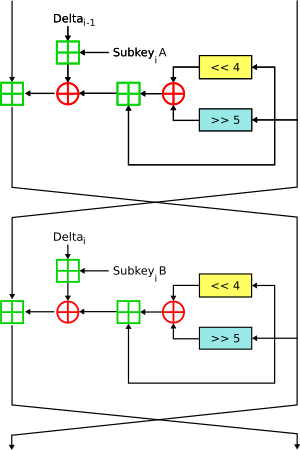Loading AI tools
Block cipher From Wikipedia, the free encyclopedia
In cryptography, XTEA (eXtended TEA) is a block cipher designed to correct weaknesses in TEA. The cipher's designers were David Wheeler and Roger Needham of the Cambridge Computer Laboratory, and the algorithm was presented in an unpublished technical report in 1997 (Needham and Wheeler, 1997). It is not subject to any patents.[1]
This article includes a list of general references, but it lacks sufficient corresponding inline citations. (September 2015) |
 Two Feistel rounds (one cycle) of XTEA | |
| General | |
|---|---|
| Designers | Roger Needham, David Wheeler |
| First published | 1997 |
| Derived from | TEA |
| Successors | Corrected Block TEA |
| Cipher detail | |
| Key sizes | 128 bits |
| Block sizes | 64 bits |
| Structure | Feistel cipher |
| Rounds | variable; recommended 64 Feistel rounds (32 cycles) |
| Best public cryptanalysis | |
| A related-key rectangle attack on 36 rounds of XTEA (Lu, 2009)[vague] | |
Like TEA, XTEA is a 64-bit block Feistel cipher with a 128-bit key and a suggested 64 rounds. Several differences from TEA are apparent, including a somewhat more complex key-schedule and a rearrangement of the shifts, XORs, and additions.
This standard C source code, adapted from the reference code released into the public domain by David Wheeler and Roger Needham, encrypts and decrypts using XTEA:
#include <stdint.h>
/* take 64 bits of data in v[0] and v[1] and 128 bits of key[0] - key[3] */
void encipher(unsigned int num_rounds, uint32_t v[2], uint32_t const key[4]) {
unsigned int i;
uint32_t v0=v[0], v1=v[1], sum=0, delta=0x9E3779B9;
for (i=0; i < num_rounds; i++) {
v0 += (((v1 << 4) ^ (v1 >> 5)) + v1) ^ (sum + key[sum & 3]);
sum += delta;
v1 += (((v0 << 4) ^ (v0 >> 5)) + v0) ^ (sum + key[(sum>>11) & 3]);
}
v[0]=v0; v[1]=v1;
}
void decipher(unsigned int num_rounds, uint32_t v[2], uint32_t const key[4]) {
unsigned int i;
uint32_t v0=v[0], v1=v[1], delta=0x9E3779B9, sum=delta*num_rounds;
for (i=0; i < num_rounds; i++) {
v1 -= (((v0 << 4) ^ (v0 >> 5)) + v0) ^ (sum + key[(sum>>11) & 3]);
sum -= delta;
v0 -= (((v1 << 4) ^ (v1 >> 5)) + v1) ^ (sum + key[sum & 3]);
}
v[0]=v0; v[1]=v1;
}
The changes from the reference source code are minor:
unsigned long type rather than the 64-bit clean uint32_t.const types.v1 += (v0<<4 ^ v0>>5) + v0 ^ sum + k[sum>>11 & 3];The recommended value for the "num_rounds" parameter is 32, not 64, as each iteration of the loop does two Feistel-cipher rounds. To additionally improve speed, the loop can be unrolled by pre-computing the values of sum+key[].
In 2004, Ko et al. presented a related-key differential attack on 27 out of 64 rounds of XTEA, requiring 220.5 chosen plaintexts and a time complexity of 2115.15.[2][3]
In 2009, Lu presented a related-key rectangle attack on 36 rounds of XTEA, breaking more rounds than any previously published cryptanalytic results for XTEA. The paper presents two attacks, one without and with a weak key assumption, which corresponds to 264.98 bytes of data and 2126.44 operations, and 263.83 bytes of data and 2104.33 operations respectively.[4]
Presented along with XTEA was a variable-width block cipher termed Block TEA, which uses the XTEA round function, but Block TEA applies it cyclically across an entire message for several iterations. Because it operates on the entire message, Block TEA has the property that it does not need a mode of operation. An attack on the full Block TEA was described by Saarinen,[5] which also details a weakness in Block TEA's successor, XXTEA.
Seamless Wikipedia browsing. On steroids.
Every time you click a link to Wikipedia, Wiktionary or Wikiquote in your browser's search results, it will show the modern Wikiwand interface.
Wikiwand extension is a five stars, simple, with minimum permission required to keep your browsing private, safe and transparent.